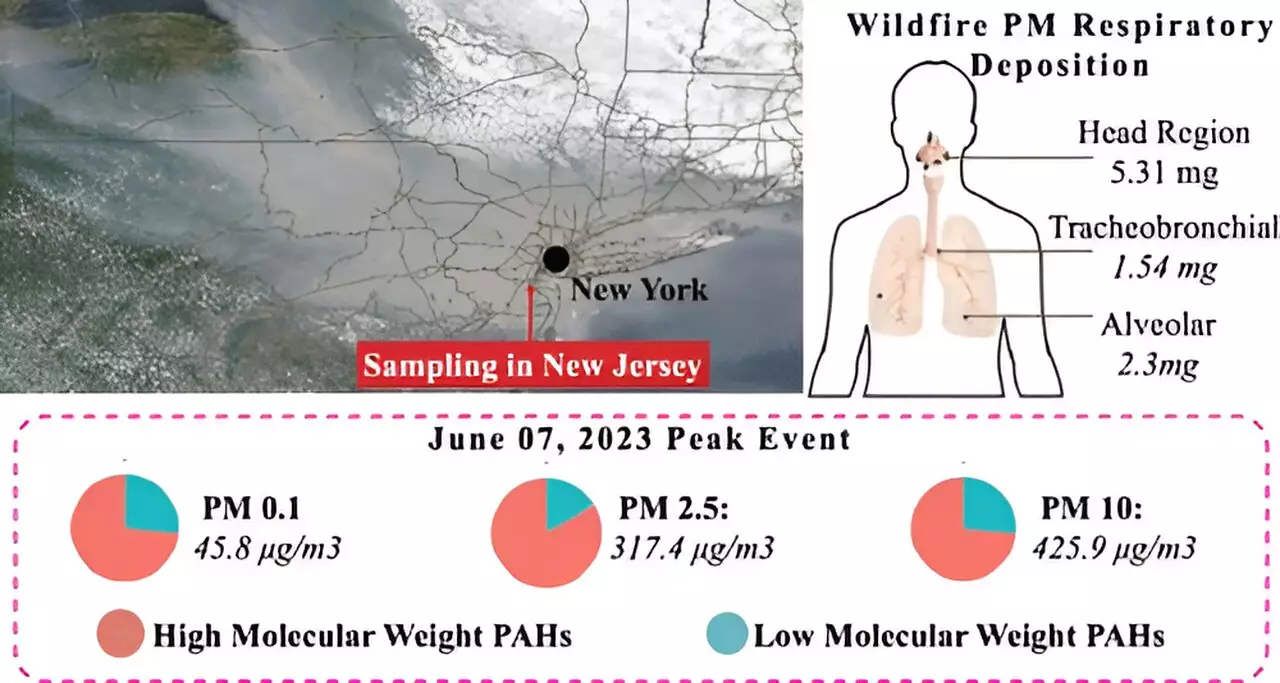Recent research conducted by Rutgers University highlights a substantial concern related to air quality and public health, particularly in densely populated regions of the Northeastern United States. Fires that broke out in June 2023 have shown how climate-driven events can produce harmful particulate matter capable of traveling significant distances. The findings indicate a troubling reversal of decades-long improvements in air quality, beckoning urgent attention from both policymakers and public health officials.
In a groundbreaking study published in *Environmental Science & Technology*, researchers characterized the particulate matter from the June wildfires, marking the first comprehensive analysis in this region associated with climate-driven flames. Lead author Jose Guillermo “Memo” Cedeño Laurent and his team utilized advanced analytical techniques to investigate the particulate matter in the air, discovering alarming concentrations of harmful substances. They reported that at the wildfire’s peak on June 7, levels of ultrafine and fine particulate matter surged to nearly ten times above the national air quality standard, raising red flags about potential health risks for millions.
Notably, the study identified high levels of polycyclic aromatic hydrocarbons (PAHs), which are well-documented carcinogens, showcasing a concerning link between wildfires and increased health hazards. This information was particularly compelling given its implications for communities already grappling with air pollution.
Emerging evidence suggests that emissions from wildfires could be exacerbating health impacts in ways unlike traditional pollution sources. Recent epidemiological studies have indicated a spike in emergency visits related to respiratory and cardiovascular issues following the fire events, a correlation that demands further investigation into the nature of these health impacts. The research underscores a critical gap in understanding how chemicals released during wildfires compare to those from other sources of air pollution.
Cedeño Laurent’s analysis revealed that over a 72-hour exposure period, the estimated inhalation dose of particulate matter in the lungs could exceed 9 micrograms. Such particulate sizes are especially worrisome because they can penetrate deep into the respiratory system, possibly leading to long-term health issues.
The Rutgers study doesn’t exist in isolation; it serves as part of a wider collaborative research effort examining the various impacts of wildfire-related particulates on different organ systems, including the lungs, heart, brain, and reproductive organs. This interdisciplinary focus is essential for a holistic understanding of how climate change is reshaping public health landscapes.
Moreover, researchers like Philip Demokritou emphasize that these findings can significantly aid public health risk assessment. The data provides a roadmap for communities already affected by ongoing air quality issues and offers strategies for adapting to the increasing frequency and intensity of wildfires—a phenomenon that is likely to worsen as climate change progresses.
The pressing nature of these findings emphasizes the need for continued investigation into the characteristics of wildfire smoke and its respective health impacts. Cedeño Laurent and Demokritou advocate for robust research into the physical and chemical processes involved in wildfire air pollution. This understanding is not just academic; it holds real-world implications for risk management and public health policy.
Additionally, ongoing studies will shed light on the optical properties of particulate matter from wildfires and its potential influences on climate change. This interconnected approach represents a valuable frontier in climate and health research, particularly as urban populations increasingly confront the ramifications of rising temperatures and changing weather patterns.
The recent wildfire events in the Northeast underscore an urgent public health crisis driven by climate change. The multifaceted impacts on air quality and health require a collective response from researchers, public health officials, and policymakers alike. As findings from Rutgers University demonstrate, the interplay between wildfires and air pollution is complex and requires further investigation to identify effective protective measures for vulnerable communities. The urgency is clear: understanding and adapting to these changes is not only beneficial but necessary for safeguarding public health in an era of climate uncertainty.

